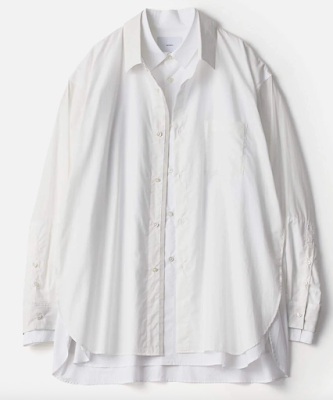The Japanese aesthetic and a Radiohead tee
As I prepare to shutter the Passage at month's end for the summer break, I'm sharing an illuminating Insta post by Australian designer Ken Sakata of Front Office, in which he explains the Japanese fashion aesthetic. (About three minutes.)
He succinctly describes four centuries-old principles identified by the scholar Donald Keene: Suggestion, Irregularity, Simplicity, and Perishability. These, he says, are very different from the Western fashion aesthetic.
As Sakata explained the principles, I understood why I enjoy secondhand clothes, seek details like functional pockets, and am wary of noisy "wearable art" items.
Last month, I found a barn-door red tee in a thrift that embodied the principles. Fine, soft cotton, simple but feminine cut, and rolled hems.
Six bucks, and it met the Giki Zero goals I set a year ago.
Usually. the modern Japanese aesthetic carries a hefty price. An oversized cotton shirt from SS Stein displays all the principles. Part of the designer Kiichiro Asakawa's description of her ethos is, "From nothing to existence; expressing the parts inbetween."
The shirt is sold out, but judging from their similar pieces, it would be over $500— so I filed this for inspiration. Eventually the ideas may filter down to a brand like Cos.
Sakata acknowledges he's making generalizations and notes that like any culture, contradictions exist. I thought of Japanese traditional clothing, such as exquisite kimono and the astonishing Japanese fireman's coats, as ornamented and (to our eye) embellished as it gets. (Photo: Interior of Japanese fireman's coat, Edo era; Museum of Modern Art.)
It explains why baroque pearls interest me more than perfect rounds, why I'm not embarrassed to wear an old, darned hoodie. I learned that Georgia O'Keefe kept new clothes for at least a year before she wore them; it seems she wanted to take the shop-new off them, and ease them into her life.
The principles are not unknown in the Western world, but Restraint is sometimes read as Resignation, and Simplicity rendered as endless rectangles, even when the materials are fine. (You know how I feel about Eileen Fisher.) The organic dyes Sakuta mentions in passing are rare; even subtle synthetic dyes seem to have vanished save for the elite Italian houses.
We aren't much for Irregularity, either, but thank the gods for JW Anderson:
 |
| Photos: JW Anderson.com |
At a more accessible prices, I turn to the Canadian designer Veronique Miljkovich. Japanese brands are cut small; her sizes run from a North American XS to an honest XL (not a 8-10 calling itself that, grrr, you Italians.) All of the clothing is made in her Nova Scotia atelier. (Note to US clients: She is presently absorbing the US-imposed tariff for shipments there.)
Top right: Romane organic cotton tee; price, $CDN 125
Bottom right: Winona fleece top; price, $CDN 235
When the Eastern aesthetic travels gracefully, sometimes I'm not immediately aware of the influence, but feel an emotional response. The clothes feel at once comfortable and stylish. In autumn, I will head for Miljkovitch for three reasons: to find this aesthetic, to Buy Canadian, and for the price point. I've collected her clothes for years; they wear well.
Another well-priced option is Vancouver's Paper Label; their Ashley tee dress (several colour options) has opened sides, so it is not really a dress, and delivers much more interest than the generic closed-seamed version. Price, $95.
 |
| Photo: Paper Label |
For now, with our cold spring finally segueing into sultry summer, the $6 vintage tee will do.







Comments
https://passagedesperles.blogspot.com/2013/10/what-is-it-about-eileen-fisher.html
Several weeks ago I was in a thrift and found a pristine EF knit linen v-neck tunic, in linen. Price, $7.50, so thought, "I should reconsider EF", and tried it on. Still a no for me, though it fit and the colour was one I can wear. It will make some other woman's day to find it!